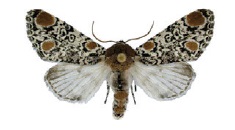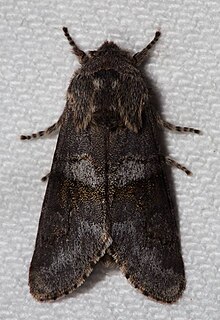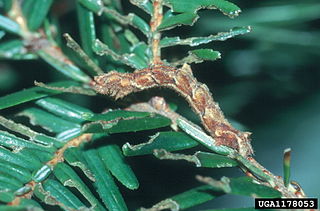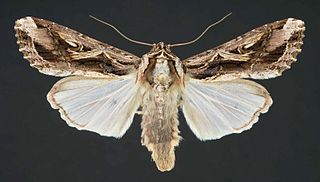
Maryland is a state in the Mid-Atlantic region of the United States, bordering Virginia, West Virginia, and the District of Columbia to its south and west; Pennsylvania to its north; and Delaware to its east. The state's largest city is Baltimore, and its capital is Annapolis. Among its occasional nicknames are Old Line State, the Free State, and the Chesapeake Bay State. It is named after the English queen Henrietta Maria, known in England as Queen Mary.

The Arctiinae are a large and diverse subfamily of moths, with around 11,000 species found all over the world, including 6,000 neotropical species. This group includes the groups commonly known as tiger moths, which usually have bright colours, footmen, which are usually much drabber, lichen moths, and wasp moths. Many species have "hairy" caterpillars that are popularly known as woolly bears or woolly worms. The scientific name of this subfamily refers to this hairiness. Some species within the Arctiinae have the word “tussock” in their common name due to people misidentifying them as members of the Lymantriinae based on the characteristics of the larvae.

Schinia, commonly called flower moths, is a large genus of moths belonging to the family Noctuidae. The genus has a Holarctic distribution with the vast majority of species being found in North America, many with a very restricted range and larval food plant.

The University of Maryland, College Park is a public research university in College Park, Maryland. Founded in 1856, UMD is the flagship institution of the University System of Maryland, and is the largest university in both the state and the Washington metropolitan area, with more than 41,000 students representing all fifty states and 123 countries, and a global alumni network of over 360,000. Its twelve schools and colleges together offer over 200 degree-granting programs, including 92 undergraduate majors, 107 master's programs, and 83 doctoral programs. UMD is a member of the Association of American Universities and competes in intercollegiate athletics as a member of the Big Ten Conference.

Anomis erosa, the yellow scallop moth or abutilon moth, is a moth of the family Erebidae. It is found in south-eastern North America. It is mostly a southern species, but migrants reach Manitoba, Quebec and Maine.

Schinia nundina, the goldenrod flower moth, is a moth of the family Noctuidae. It is found from Minnesota to southern Ontario and Nova Scotia, south to central Florida and southern Texas. Records include Arizona, Kansas, Nebraska, New York, Maryland, Oklahoma and South Carolina.
The sordid wainscot or tufted sedge moth is a species of moth of the family Noctuidae. It is found across Canada from Newfoundland to British Columbia, south in the east to Connecticut and Ohio and in the west to Colorado.

Acronicta modica, the medium dagger moth, is a moth of the family Noctuidae. It is found from Ontario and Quebec south to Arizona and Texas. It has also been recorded from Pennsylvania, Maryland, Iowa and Wisconsin.
Acronicta tristis is a moth of the family Noctuidae. It is found from Ontario, Quebec and New Brunswick, south to Maryland, Pennsylvania and Ohio.

Harrisimemna trisignata is a moth of the family Noctuidae. It is found from Ontario, Quebec, New Brunswick, Nova Scotia, Newfoundland and Labrador, Alberta and Saskatchewan, south to Arizona. In the United States it has been recorded in Maryland, Pennsylvania, Wisconsin, Georgia, Illinois, Indiana, Iowa, New York, Ohio, Oklahoma, Tennessee, Texas and Virginia.

Apamea indocilis, the ignorant apamea, is a moth of the family Noctuidae. It is native to North America, where it is distributed throughout southern Canada and the northern United States. In the east its range extends from Newfoundland to South Carolina. In the west it occurs as far south as San Francisco Bay and in the Rocky Mountains to New Mexico.
The wet sand savannah moth is a species of moth in the family Erebidae. The species is found from Manitoba south to Maryland, Massachusetts and New York.

The camphorweed flower moth or brown flower moth is a moth of the family Noctuidae. It is found from Oklahoma to New Jersey, south to Florida and Texas. Its range is expanding in the north-east. Furthermore recorded from Colorado, Kansas, Oklahoma, Arkansas, North Carolina, South Carolina and Maryland.

The gray sallow is a species of moth of the family Noctuidae. It is found from Ontario, south to Florida. It has been recorded from Iowa, New York, Maryland, South Carolina, Arkansas, Michigan and Wisconsin.

Nemoria saturiba is a moth of the family Geometridae. It is found from Florida to North Carolina and in South Carolina, Virginia, Kentucky, Tennessee, Alabama, Mississippi, Louisiana and eastern Texas. In the north, it is found at least up to Maryland.

Nemoria mimosaria, the white-fringed emerald or flanged looper, is a moth of the family Geometridae. It is found from Nova Scotia to south-eastern Alberta, south to Virginia, Illinois, and Texas.

Spodoptera dolichos is a moth of the Noctuidae family found from the southern United States, south through Costa Rica to South America, as far south as Argentina. In the United States, it may occur as far north as Kentucky and Maryland.

Ptichodis herbarum, the common ptichodis moth, is a moth in the family Erebidae. It is found in the United States. It has also been recorded from Jamaica.
Spilosoma latipennis, the pink-legged tiger moth, or the red-legged diacrisia, is a moth in the family Erebidae. It was described by Richard Harper Stretch in 1872. It is found in eastern North America, where it has been recorded from Georgia, Indiana, Iowa, Kansas, Kentucky, Maine, Maryland, New Brunswick, New York, North Carolina, Ohio, Ontario, Pennsylvania, South Carolina, West Virginia and Wisconsin.
Diastictis argyralis, the white-spotted orange moth, is a moth in the family Crambidae. It was described by Hübner in 1818. It is found in North America, where it has been recorded from Colorado, Florida, Georgia, Indiana, Maine, Maryland, Mississippi, North Carolina, Ohio, Ontario, South Carolina, Tennessee, Texas and Virginia.




















